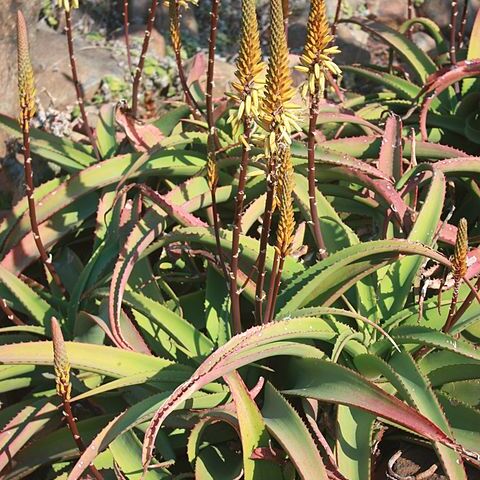Plants usually on flat rocky places in large dense groups. Stem none, or very short, (20-30 cm.), dividing at the summit and branching at ground level, and forming dense groups. Leaves densely rosulate, 70-80 cm long, 12-15 cm broad when pressed flat, lanceolate long-attenuate, erectly spreading and decurved, sometimes twisted, with the apices of lowest leaves almost touching the ground; upper surface very deeply channelled, with the margins sometimes somewhat involute, green to copper-red, usually obscurely lineate; lower surface very convex, usually greener than the upper surface; margins sinuate-dentate, somewhat horny, reddish to reddish-brown, armed with widely deltoid reddish pungent teeth about 3-5 mm long, 10-15 mm distant. Inflorescence about 1 met. high, 2-3-branched from about the middle. Peduncle brown, not sterile-bracteate below the first branch, but branches below racemes with several ovate-acute many-nerved thin dry sterile bracts, about 15 mm long, 8 mm broad. Racemes rather narrowly conical, up to 25-30 cm long, 8-10 cm diam., sub-densely flowered, usually unicoloured orange-yellow, sometimes unicoloured dull red, occasionally bicoloured with dull red buds, and buff-yellow flowers. Bracts the lowest 15 mm long, about 7 mm broad at base, ovate-acute, thin, sub-scarious, pale, with several reddish to brownish nerves. Pedicels the lowest 20 mm long, gradually shorter upwards. Perianth cylindric-trigonous, slightly compressed laterally, averaging 35 mm long, usually buff-yellow (Tt.C.S. IV), sometimes dull red; outer segments free, conspicuously 3-nerved, the nerves green and confluent at apex, the apices sub-acute slightly spreading; inner segments broader than the outer, rather pale, with 3 congested nerves forming a keel the colour of the perianth turning green at apex, apices more obtuse more spreading. Leaves densely rosulate, 70-80 cm long, 12-15 cm broad when pressed flat, lanceolate long-attenuate, erectly spreading and decurved, sometimes twisted, with the apices of lowest leaves almost touching the ground; upper surface very deeply channelled, with the margins sometimes somewhat involute, green to copper-red, usually obscurely lineate; lower surface very convex, usually greener than the upper surface; margins sinuate-dentate, somewhat horny, reddish to reddish-brown, armed with widely deltoid reddish pungent teeth about 3-5 mm long, 10-15 mm distant. Inflorescence about 1 met. high, 2-3-branched from about the middle. Peduncle brown, not sterile-bracteate below the first branch, but branches below racemes with several ovate-acute many-nerved thin dry sterile bracts, about 15 mm long, 8 mm broad. Racemes rather narrowly conical, up to 25-30 cm long, 8-10 cm diam., sub-densely flowered, usually unicoloured orange-yellow, sometimes unicoloured dull red, occasionally bicoloured with dull red buds, and buff-yellow flowers. Bracts the lowest 15 mm long, about 7 mm broad at base, ovate-acute, thin, sub-scarious, pale, with several reddish to brownish nerves. Pedicels the lowest 20 mm long, gradually shorter upwards. Perianth cylindric-trigonous, slightly compressed laterally, averaging 35 mm long, usually buff-yellow (Tt.C.S. IV), sometimes dull red; outer segments free, conspicuously 3-nerved, the nerves green and confluent at apex, the apices sub-acute slightly spreading; inner segments broader than the outer, rather pale, with 3 congested nerves forming a keel the colour of the perianth turning green at apex, apices more obtuse more spreading. Filaments filiform-flattened, the 3 inner narrower and lengthening in advance of the 3 outer. Anthers the 3 inner and 3 outer in turn exserted 10 mm Stigma at length exserted 10-12 mm and remaining exserted after the perianth dries.
More
Plants almost stemless, 300-600 mm tall, in dense groups. Leaves many per rosette, 500-800 x 90-150 mm, deeply channelled, green to copper-red. Inflorescence a 2-or 3-branched dense, cylindric-conical raceme ±1 m tall; peduncle without sterile bracts below first branch; bracts ovate-obtuse, 15-17 x 6-7 mm, 7-many-nerved. Flowers orange-yellow, dull red or bicoloured, 30-40 mm long; pedicels 14-23 mm long, lengthening to 25-30 mm in fruit. Anthers exserted 1-10 mm. Ovary ±5 x 2 mm; style exserted 9-12 mm.
A succulent shrub. It is low growing and forms clumps.

